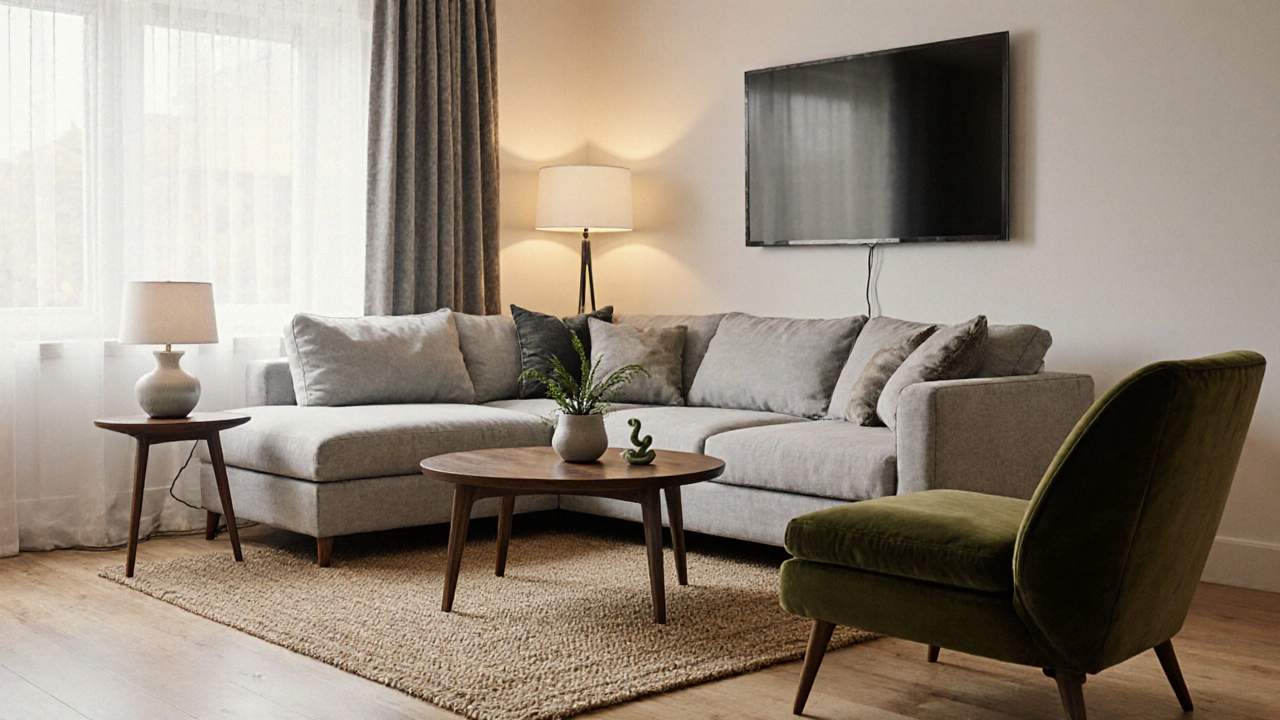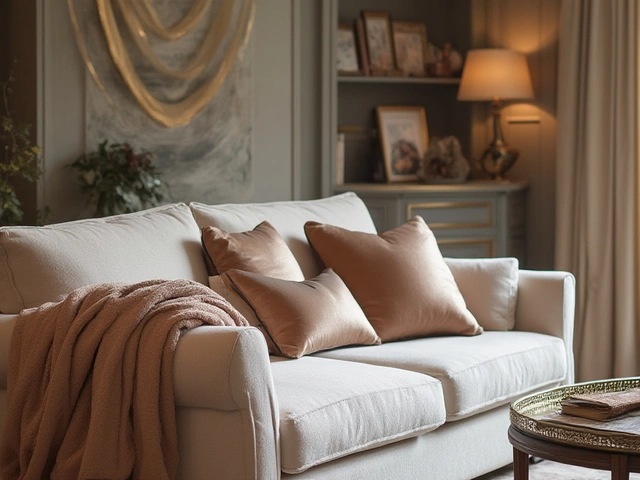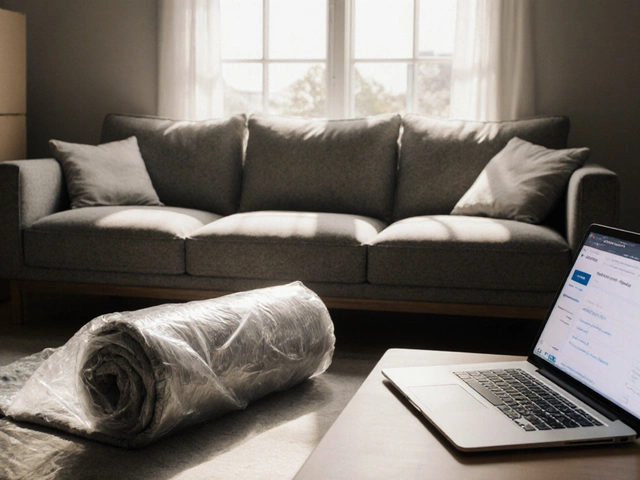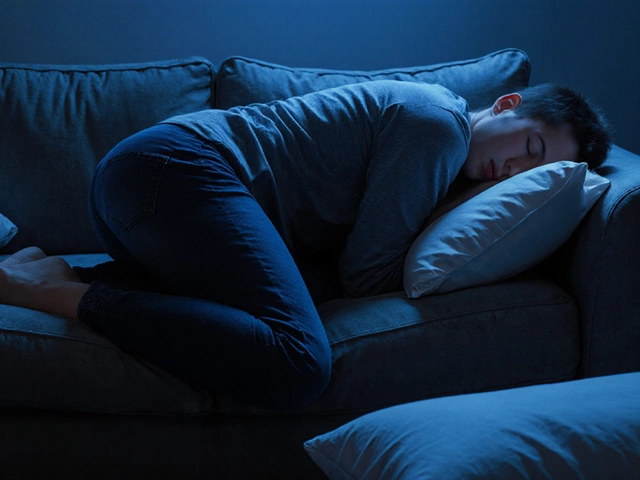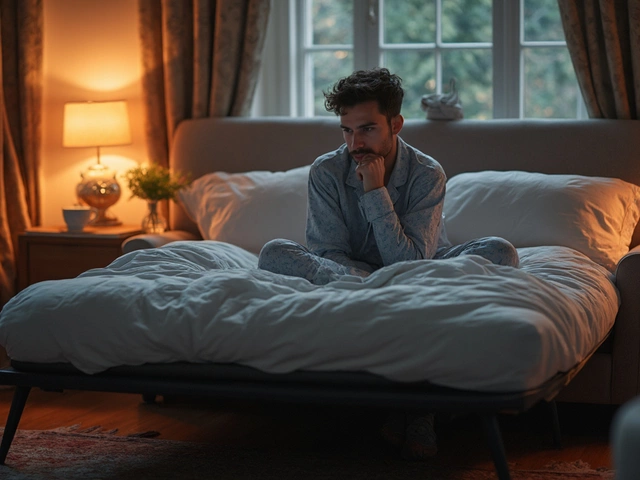Corner Sofa Coffee Table Calculator
Calculate Your Perfect Coffee Table
The coffee table is the anchor of your living room layout. With a corner sofa, you need the right size to create balance without crowding.
Recommended Coffee Table Length
-
Corner sofas are one of the most popular choices for modern living rooms. They fit snugly into corners, save space, and offer plenty of seating. But once you bring one home, the real question hits: what to pair with a corner sofa? It’s not just about finding a coffee table. It’s about creating a room that feels balanced, functional, and inviting-not like a furniture showroom with everything shoved in haphazardly.
Start with the coffee table
The coffee table is the anchor of your living room layout. With a corner sofa, you have more flexibility than with a straight sofa. You can place a single large table in front, or go for two smaller ones on either side of the corner. A rectangular or oval table works best if you want to keep traffic flowing. Avoid round tables unless your sofa has a very gentle curve-those can feel awkward and leave dead space.Size matters. If your corner sofa is large (say, over 2.5 meters wide), go for a coffee table that’s at least 1.2 meters long. Too small, and it looks lost. Too big, and you’ll bump your knees every time you stand up. A good rule of thumb: the coffee table should be about two-thirds the length of the longest sofa section. Materials like wood, stone, or even a sturdy glass top add warmth and durability. Avoid plastic or cheap metal frames-they scream temporary.
Side tables? Yes, but strategically
One of the biggest mistakes people make is skipping side tables entirely. A corner sofa often has two ends-each one is a natural spot for a small table. One end might face a window; the other might sit near a bookshelf or floor lamp. Don’t leave either side empty.Choose slim, low-profile side tables. Something around 50-60 cm tall works best. You want to be able to set down a drink, a book, or a remote without leaning forward. A wooden side table with an open shelf underneath is ideal-it adds storage without bulk. If you’re tight on space, try wall-mounted floating shelves. They hold lamps, plants, or framed photos without eating up floor space.
Lighting: Don’t skip the floor lamp
Corner sofas often sit away from windows, which means natural light doesn’t reach all the way to your seating. That’s where lighting comes in. A tall floor lamp placed beside one end of the sofa creates a cozy reading nook. Pick one with a wide shade-it diffuses light evenly instead of casting harsh spots.Try a lamp with a dimmer switch. You don’t want to turn on the main ceiling light every time you want to relax. If your corner sofa has a chaise, place the lamp behind it, not beside it. That way, the light doesn’t shine directly in your eyes when you’re lying back. LED bulbs with a warm white tone (2700K-3000K) give off that soft, golden glow that makes everyone look better and feel more relaxed.
Area rugs define the space
A corner sofa without a rug looks like it’s floating. Rugs ground the seating area and tie the whole room together. The right rug makes your living room feel intentional, not accidental.Size is critical. Your rug should be large enough so that the front legs of your sofa sit on it. If you have a large corner sofa, aim for a rug that’s at least 2.4 x 3 meters. Smaller rugs make the room feel cramped. Avoid thin, low-pile rugs-they don’t add comfort or sound absorption. Go for wool, cotton, or a blend with a medium pile. Patterns help hide spills and wear, so don’t shy away from subtle geometric designs or muted florals.
Color-wise, match your rug to your sofa’s undertones. If your sofa is charcoal gray, a rug with navy or warm beige tones pulls it together. If your sofa is beige or light brown, a rug with hints of rust or olive adds depth. Never go for a rug that’s the exact same color as your sofa-it disappears.
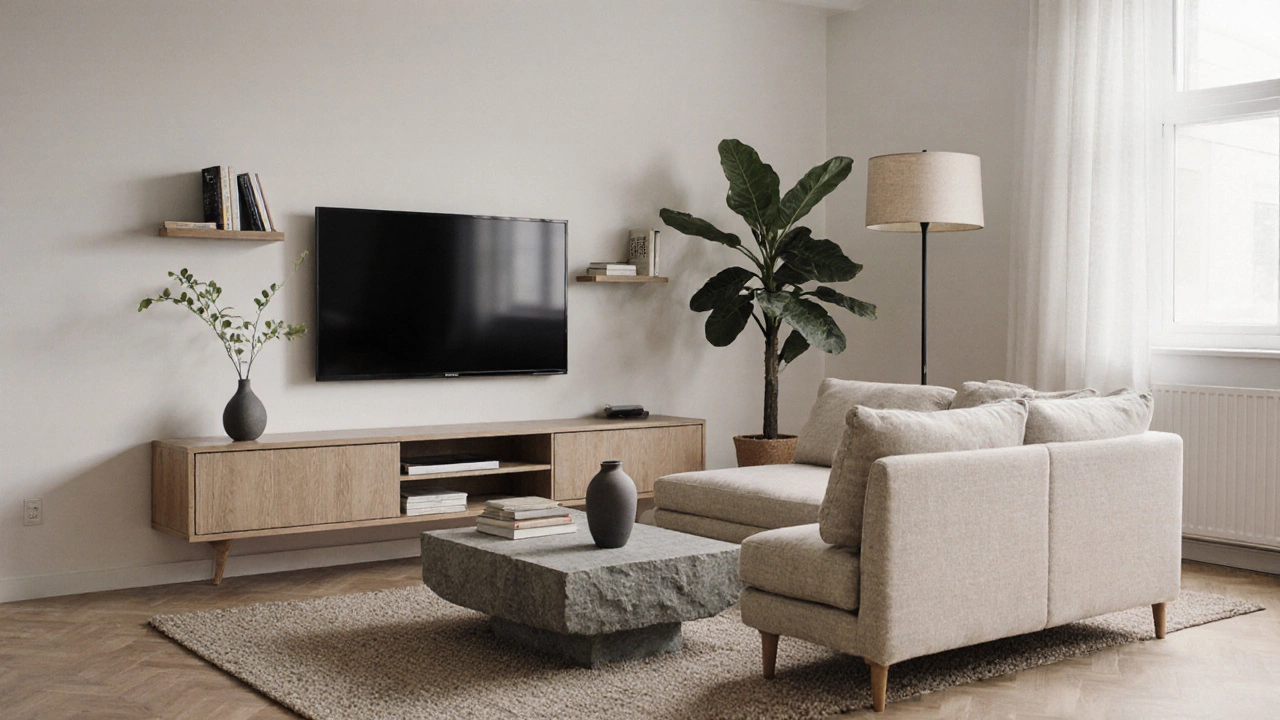
Entertainment setup: Keep it clean
Most people put their TV opposite the sofa. With a corner sofa, you have options. You can mount the TV on the wall across from the chaise, or place it on a media console beside the corner. Avoid putting the TV directly in front of the corner-it forces everyone to twist awkwardly to watch.Use a low-profile TV stand or wall mount. If you’re using a stand, make sure it’s no taller than 40 cm. You don’t want the screen above eye level when seated. Hide cables with a cable management box or run them behind the wall. Wireless speakers are a game-changer-no need for messy wires snaking across the floor. If you have a soundbar, place it under the TV, not on a shelf next to it. That keeps the focus on the screen, not the clutter.
Storage: Hide the mess
Corner sofas often come with built-in storage, but you’ll still need extra. A low storage bench at the foot of the sofa is perfect for blankets, pillows, or board games. Look for one with a lift-top lid or open cubbies. A narrow console table behind the sofa works well too-if there’s space. It’s great for books, a vase, or a small lamp.Don’t overdo it. Too many storage pieces turn your living room into a warehouse. Pick one or two functional items that match your sofa’s style. If your sofa is modern and minimalist, go for clean-lined storage. If it’s rustic or upholstered in linen, choose wood or woven baskets. Avoid plastic bins-they look cheap and don’t blend in.
Accent chairs? Only if space allows
Some people think adding an accent chair balances the room. But with a corner sofa, you’re already getting maximum seating. Adding another chair can overcrowd the space unless you have a large room.If your living room is over 4 meters wide, a single armchair placed diagonally across from the corner can work. Choose one with a low back and slim arms. A mid-century modern design or a sleek velvet chair adds texture without bulk. Never place two accent chairs-they’ll fight for space and make the room feel cluttered. One is enough. Less is more.
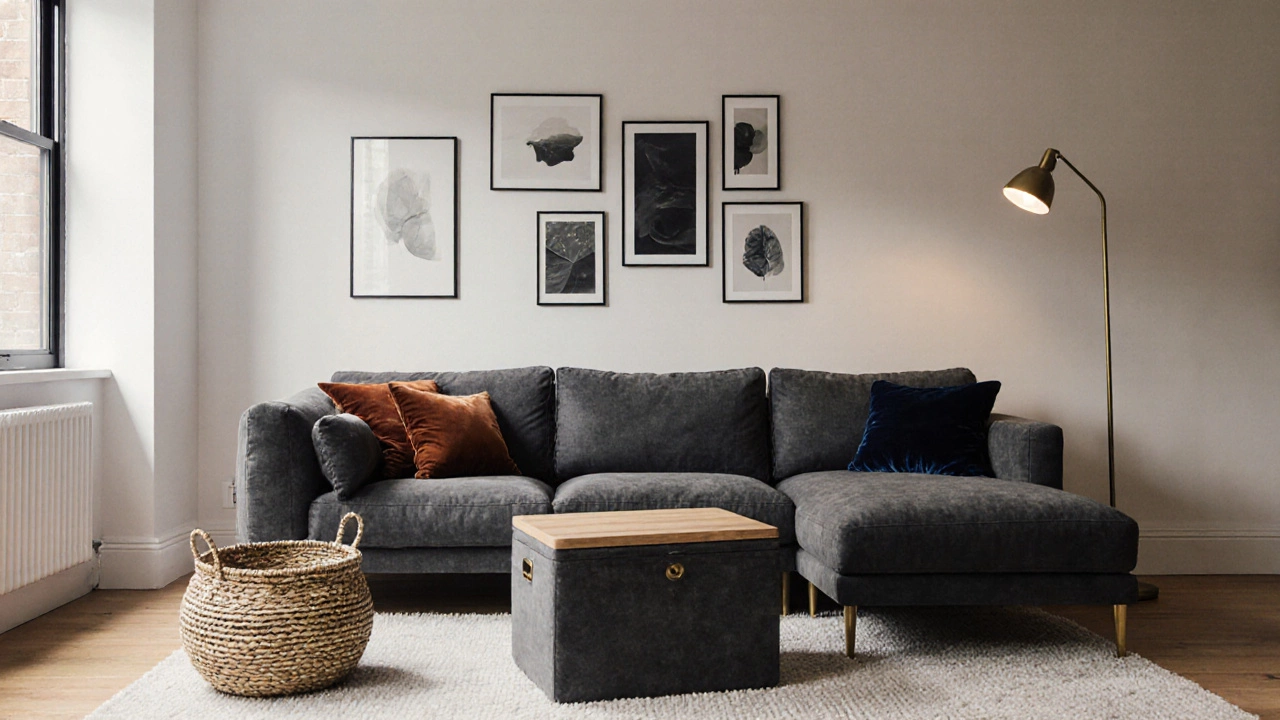
Plants and decor: The finishing touches
Plants bring life to any room. A tall fiddle-leaf fig in a corner near the sofa adds height and greenery. Smaller plants on side tables-like snake plants or succulents-add personality without taking up room. Avoid fake plants. They look dusty and cheap after a few months.Artwork should hang at eye level, about 15 cm above the sofa back. A single large piece or a narrow vertical gallery wall works best. Avoid small, scattered frames-they look like an afterthought. Throw pillows are great, but limit them to three or four. Mix textures: linen, wool, velvet. Don’t use all the same pattern. One bold print and two solids is the sweet spot.
What not to do
Here are the top three mistakes people make with corner sofas:- Putting the TV too close to the corner-forces neck strain
- Using a tiny rug that only covers the front legs-looks unfinished
- Overloading with too many side tables or storage units-makes the room feel cluttered
Also, avoid matching everything. Don’t buy a coffee table, side tables, and rug all from the same set. That looks like a catalog, not a home. Mix materials. Pair wood with metal. Combine woven textures with smooth leather. That’s what makes a space feel lived-in and personal.
Real-life example: Auckland living room
In a 5x4 meter apartment in Ponsonby, a light gray corner sofa sits with a dark walnut coffee table in front. A 2.5m jute rug covers the floor, with the sofa’s front legs resting on it. A slim wooden side table holds a ceramic lamp and a small snake plant. A single armchair in olive velvet sits diagonally across. The TV is mounted on the wall beside the chaise, with a hidden cable box behind the sofa. No extra storage-just a woven basket under the coffee table for blankets. The result? A calm, functional space that feels cozy, not crowded.Can I put a corner sofa in a small living room?
Yes, but choose a compact model. Look for corner sofas under 2.2 meters in total length. Place it in the corner with space to walk around. Pair it with a small coffee table and avoid bulky side tables. Use a rug that covers the front legs only-don’t go too large. Wall-mounted shelves and slim floor lamps help keep the space open.
Should my coffee table match my corner sofa?
No, and it shouldn’t. Matching furniture looks staged. Instead, choose a coffee table that complements the sofa’s tone. If your sofa is cool gray, pick a warm wood table. If your sofa is beige, try a black metal or dark stone top. Contrast creates depth. The goal is harmony, not clones.
How do I arrange seating if I have a large corner sofa and guests?
Your corner sofa already seats three to four people. For larger gatherings, add one or two foldable chairs or ottomans that can be tucked away. Avoid permanent extra seating-it eats up space. When guests come, pull out the ottomans, place them near the sofa, and use them as extra seats or footrests. Keep them in a closet or under a bench when not in use.
What’s the best way to clean a corner sofa?
Vacuum the cushions and crevices weekly with a brush attachment. For fabric sofas, spot-clean stains with a mix of mild soap and water-never soak it. Leather sofas need a damp cloth and a leather conditioner every 6 months. Always check the manufacturer’s care label. Some fabrics are machine-washable; others require professional cleaning. Protect your sofa with a stain-resistant spray when you first bring it home.
Can I put a corner sofa in front of a window?
Yes, but only if the window is on the side, not directly behind it. A corner sofa placed with the chaise against a window works well-it lets in natural light and creates a reading nook. Avoid placing the main seating directly in front of a large window unless you have blackout curtains. Otherwise, glare on the TV and too much sun on the fabric will be a problem.
